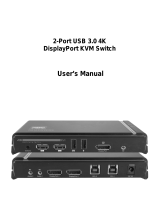
13
Basic Operation
Manual Port Selection:
■ Press and release a port selection pushbutton to bring the focus of the KVM focus to the
computer attached to the corresponding port. USB and Audio focus do not change – they
stay with the port that they are already on.
■ Press a port selection pushbutton twice to bring the audio focus to the computer attached
to its corresponding port.
■ Press and hold a port selection pushbutton for more than 2 seconds to bring the KVM
focus, plus the USB and Audio focus to the computer attached to its corresponding port.
■ Press and hold port selection pushbutton 1 and 2 for more than 2 seconds to start Auto
Scan Mode (see Auto Scan Mode section for more details).
■ Press and release either port selection pushbutton to stop Auto Scan Mode. The KVM
focus goes to the computer attached to the corresponding port of the switch you pressed.
Hot Plugging
The GCS1902/1904 support USB hot plugging – components can be removed and added
back into the installation by unplugging their cables from the USB hub ports, without the
need to shut the unit down.
Powering OFF and Restarting
If it becomes necessary to Power OFF the GCS1902/1904, before switching it back ON, you
must follow below steps:
1. Shut down or Power OFF all computers that are attached to the GCS1902/1904.
2. Unplug the power adapter cable from GCS1902/1904.
3. Wait for 10 (ten) seconds, then connect the power adapter cable back into the
GCS1902/1904.
4. After the GCS1902/1904 turns ON, power ON all the attached computers.
Port ID Numbering
1. Each KVM port section on the GCS1902/1904 is assigned a port number
1 or 2 for the GCS1902
1, 2, 3, or 4 for the GCS1904
2. The port numbers are marked on the rear panel of the GCS1902/1904.
3. The Port ID of a computer is derived from the KVM port number it is connected to. For
example, a computer connected to KVM port 2 has a Port ID of 2.
4. The Port ID is used to specify which computer gets the KVM, USB peripheral, and
audio focus with the Hotkey port selection method (see Hotkey Operation for details).
There are three convenient methods to access the computer:
• Manual – involves pressing the port selection pushbuttons located on the
GCS1902/1904’s front panel.
• Hotkey – involves entering combinations from the keyboard (see Hotkey Operation
section for details).
• Mouse – involves pressing the mouse wheel button (clicking it twice) to switch between
ports (see Mouse Emulation and Mouse Port Switching section for more details).





















